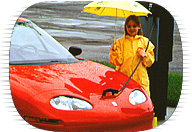
EV Charging Safety

The official blurb from GM on the Magnecharger:
The engineers of the MagneCharge™ inductive charging system wanted to make charging the EV1 so safe that you could stand in the rain, up to your ankles in water and charge your electric car. They accomplished this and more. The chargers and charging paddles were frozen, jetted with water, steamed, smashed with swinging weights and generally submitted to extreme tests. As a result, you can charge the car inside or outdoors.
The charging coupler has no exposed metal contacts — power is transferred via a high frequency magnetic field. All of the complex components are contained inside a plastic cover. This plastic composite skin is so strong that even if you run over it with your car (although we don't advise it) or freeze it, the skin won't crack. If you try to drive off with the charger properly connected, the car's computer won't let you. If the charging cable is ever damaged or cut, this will be detected by monitors that continuously check electric circuits, and the power will shut off within milliseconds.
The Underwriters Laboratories' (UL) safety standards are the most widely recognized and used safety standards in the United States. No other certification mark is more widely accepted by consumers, regulatory authorities and the insurance industry throughout the world. The EV1 incorporates an inductive charger, charging system and battery pack which have been tested and listed by Underwriters Laboratories. This includes the software controls, the chargers and the charge port. As such, the car and chargers can be used with the same confidence you have in other household appliances carrying the familiar 100-year-old UL Mark.
Would you allow your 18-month-old child to
fuel your gasoline car?

 |
Click for |